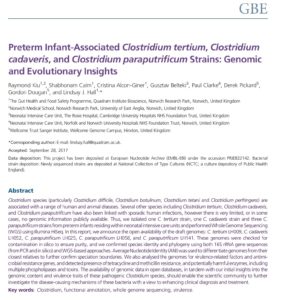New publication in Genome Biology and Evolution

We have recently published a journal article in Genome Biology and Evolution that describes 5 novel bacterial strains that we isolated as part of a wider Hall Lab study, examining the microbiota of preterm infants (BAMBI). These bacterial isolates, belonging to the genus Clostridium, came from fecal samples of preterm babies residing within Neonatal Intensive Care Units (NICU) of the Norwich and Norfolk Hospital (NNUH) and Rosie Hospital in Cambridge. Importantly, members of Clostridium can cause serious infection, and the species/strains we isolated were Clostridium cadaveris (a tissue-decomposing bacterium in dead bodies), Clostridium tertium (linked to neonatal gut infection) and C. paraputrificum (known to be associated with paediatric infection).
As these strains have been associated with infant infections we wanted to genetically characterise these bacteria as there was no genomic information available. Hence, we DNA sequenced the entire genome (the collection of all the genes in an individual organism), and performed computational analysis to understand how these bacteria relate to their closest relatives, and investigate what genes these bacteria have that may contribute to their ability to cause infection. Interestingly, C. cadaveris carries genes that encode degradation proteins that can break-down proteins, which is distinct from C. tertium and C. paraputrificum, and may be linked to its known ecological niches – dead carcasses. In addition, several potential disease-causing genes were also identified, including antibiotic resistance genes (resistant against tetracycline, methicillin and vancomycin), and several toxin genes (phospholipase: alpha-toxin in Clostridium perfringens; Toxin A: a homologous Clostridium difficile toxin). The prevalence of multidrug resistance in these bacterial strains might indicate the selective pressure from the environments they survived in – preterm infants residing in NICUs, where antibiotic drugs were used intensively.
So the wider research community can use these strains, and our genomic data, we made our data available openly for the very first time on ENA (public data repository) under project accession PRJEB22142. Furthermore, we also deposited all 5 strains at National Collection of Type Cultures (NCTC; a culture depository of Public Health England) to make them accessible around the globe. Their new allocated NCTC references are as follows:
• Clostridium tertium LH009: NCTC 14034
• Clostridium paraputrificum LH025: NCTC 14035
• Clostridium cadaveris LH052: NCTC 14036
• Clostridium paraputrificum LH058: NCTC 14037
• Clostridium paraputrificum LH141: NCTC 14038
These strains are now being processed at NCTC, and I believe they will be appear on NCTC website soon!
Kiu, R. et al. Preterm Infant-Associated Clostridium tertium, Clostridium cadaveris, and Clostridium paraputrificum Strains: Genomic and Evolutionary Insights. Genome Biol Evol 9, 2707-2714, https://doi.org/10.1093/gbe/evx210 (2017).






